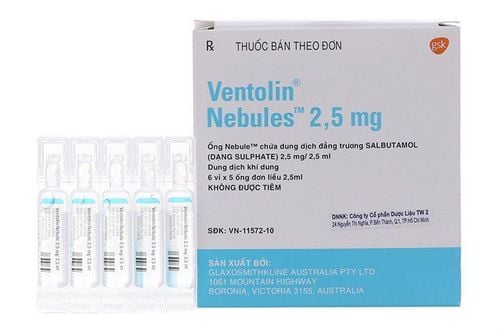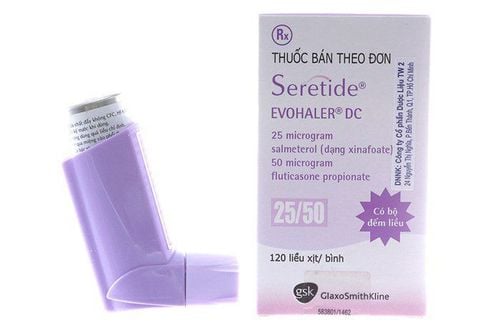This is an automatically translated article.
Obstructive lung disease is a very common respiratory disease. In addition to more cutting bronchodilators or prophylactic corticosteroids, patients can use Roflumilast. So what does Roflumilast drug do?
1. What is Roflumilast drug?
Roflumilast is an active ingredient in the treatment of obstructive airways disease, made in the form of tablets with the content of Roflumilast 250 mcg and Roflumilast 500 mcg.
Roflumilast is essentially a PDE4 inhibitor or a nonsteroidal anti-inflammatory agent that targets both the systemic inflammatory response and pulmonary inflammation associated with COPD. The drug inhibits the enzyme PDE4 in the metabolic cycle adenosine monophosphate (cAMP), found in structural and inflammatory cells important for the pathogenesis of COPD. Roflumilast is active on PDE4A, 4B and 4D splicing variants with similar potency, but the affinity for PDE4C splicing variant is 5-10 times lower. This mechanism of action is similar to that of Roflumilast N-oxide, a major active metabolite of Roflumilast.
Pharmacokinetic characteristics:
Absorption: The absolute bioavailability of roflumilast after a dose of 500 mcg is about 80%. The maximum plasma concentration is reached about 1 hour after dosing on an empty stomach, while the maximum concentration of the N-oxide metabolite is observed after about 8 hours; Distribution: Roflumilast and its active metabolite plasma protein binding are approximately 99% and 97%, respectively; Metabolism: Roflumilast is extensively metabolised via phase I (cytochrome P450) and phase II (conjugated) reactions; Elimination: The oral half-lives of Roflumilast and its metabolite are 17 and 30 hours, respectively.
2. Indications and contraindications of Roflumilast
Roflumilast is used for the purpose of maintaining treatment of severe chronic obstructive pulmonary disease (FEV1 less than 50% predicted after bronchodilator) with comorbidities such as chronic bronchitis in patients with chronic obstructive pulmonary disease. adult patients with a history of frequent exacerbations during bronchodilator therapy.
Contraindications of Roflumilast 250 mcg and 500mcg:
Allergy to active ingredient Roflumilast or any excipients in the drug; Moderate or higher hepatic impairment (Child-Pugh grade B or C).
3. Instructions for dosage and how to use Roflumilast
For adults:
The starting dose is 250 micrograms/day, equivalent to 1 Roflumilast 250 mcg tablet taken once for 28 days; After 28 days of treatment at 250 mcg, patients with COPD must be adjusted to 1 Roflumilast 500 mcg tablet, taken once a day. For other subjects:
Using the same dose as adults, no dose adjustment of Roflumilast is required in the elderly, with mild renal or hepatic impairment (Child-Pugh A).
4. What are the drug side effects of Roflumilast?
Some common side effects when taking Roflumilast:
Weight loss, increased appetite; Sleep impairment; Headache; Digestive disorders such as nausea, diarrhea, abdominal pain. Some rare side effects of Roflumilast :
Occurrence of hypersensitivity to the drug; Dizzy; palpitations, palpitations ; Gastrointestinal disturbances, vomiting, gastritis or gastroesophageal reflux; Skin rash; Muscle spasms, aches, back pain; Body weakness, fatigue; Having suicidal thoughts, feelings of anxiety, depression or panic; Respiratory infections (excluding pneumonia); Constipation; Increase liver enzymes ; Hives; Increased blood creatine and phosphokinase.
5. Some notes when using Roflumilast
Roflumilast has no effect on acute bronchospasm; It is recommended that patients should check their body weight regularly, when an unexplained weight loss is noted, they should stop taking Roflumilast and monitor their body weight; According to recommendations Roflumilast is not suitable for use in cases of severe immunological diseases (HIV infection, multiple sclerosis, lupus erythematosus, progressive multifocal encephalopathy), severe acute infectious diseases, cancer except for basal cell carcinoma) or who are taking immunosuppressive drugs (such as methotrexate, azathioprine, infliximab, or long-term oral corticosteroids). Studies in subjects with latent infections such as tuberculosis, viral hepatitis, herpes and herpes zoster are limited; Patients with congestive heart failure (NYHA grades 3 and 4) have not been studied with Roflumilast, so this product is not recommended for this population; Roflumilast increases the risk of certain psychiatric disorders such as insomnia, anxiety, mental stress and depression. Therefore, patients with a history of depression are not recommended to use Roflumilast, especially in depressed people with suicidal ideation or behavior. At the same time, during the use of Roflumilast, if new psychotic symptoms, suicidal ideation or behavior appear, immediately stop treatment; Side effects such as diarrhea, nausea, abdominal pain and headache mostly appear during the initial period of treatment with Roflumilast and may improve with continued use of the drug; Treatment with Roflumilast resulted in an increased risk of sleep disturbances, especially in patients weighing less than 60 kg due to higher PDE4 inhibitory activity; Roflumilast drug should not be used in women of reproductive age and if used, it is necessary to apply effective methods of contraception; Caution to pregnant women: Roflumilast was able to cross the placenta in study rats and most animal studies have shown reproductive toxicity. Therefore, Roflumilast is not recommended for use during pregnancy; Note to Lactation: Pharmacokinetic data in animal studies suggest the excretion of Roflumilast or its metabolites into breast milk. Because a risk to the nursing infant cannot be excluded, Roflumilast is not recommended for use in nursing women.
6. Roflumilast drug interactions
Both Roflumilast and its metabolite Roflumilast N-oxide confer an intrinsic phosphodiesterase-4 (PDE4) inhibitory effect. Therefore, after oral administration, the total PDE4 inhibitory effect is considered to be the combination of both Roflumilast and Roflumilast N-oxide;
Co-administration of Roflumilast with CYP1A2/3A4 inhibitors or CYP1A2/2C19/3A4 inhibitors may increase Roflumilast's total PDE4 inhibitory activity;
Rifampicin induces cytochrome P450 enzymes, thereby reducing total PDE4 inhibitory activity by about 60%. Therefore, the combined use of potent cytochrome P450 enzyme inducers (such as Phenobarbital, Carbamazepine, Phenytoin) may reduce the therapeutic effect of Roflumilast;
Roflumilast can be taken with or without food. However, when Roflumilast is administered with high-fat meals, it is possible to decrease and slow down Cmax and Tmax, but has no effect on the AUC of Roflumilast or its active metabolite.
In summary, Roflumilast is an active ingredient in the treatment of obstructive airways disease, made in the form of tablets with the content of Roflumilast 250 mcg and Roflumilast 500 mcg. Roflumilast is used for the maintenance treatment of severe chronic obstructive pulmonary disease. To ensure effective treatment and avoid side effects, patients need to take drugs according to prescription or under the direction of a doctor or pharmacist.
Follow Vinmec International General Hospital website to get more health, nutrition and beauty information to protect the health of yourself and your loved ones in your family.
Please dial HOTLINE for more information or register for an appointment HERE. Download MyVinmec app to make appointments faster and to manage your bookings easily.













